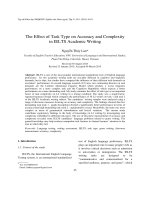IELTS academic writing test sample answers
Bạn đang xem bản rút gọn của tài liệu. Xem và tải ngay bản đầy đủ của tài liệu tại đây (112.91 KB, 2 trang )
The Official Cambridge Guide to IELTS
IELTS ACADEMIC WRITING TEST
TASK 1 Page 283
The diagrams below chart the development of Stokeford Village over an 80-year
period from 1930 to 2010. It is apparent from the data presented that Stokeford has
become increasingly populated over this time frame, with a number of new
properties replacing land that was previously used for arable purposes.
In terms of specific changes to the area, two new roads have been created in the
north of the village. These split off from the main road, with the eastern-facing road
replacing old farmland, and with the old shops demolished to make way for the
western-facing road. Both new roads are accompanied by a small number of new
houses on either side. The primary school opposite the post office has been
extended to include two new buildings attached to the rear of the property. A new
road to the south-west of the school branches off from the main road and extends
out to the river (with a series of adjoining properties), but eventually curves back
into the main road a little further south. The area where the large house was
previously situated has been substantially altered, with the gardens having been cut
back to allow four new houses to be built, and the large house has been converted
into a retirement home, with two extra buildings added to the previous three.
Finally, at the southernmost edge of the map, farmland has again been converted to
residential use, with a number of new properties attached to the road heading
south.
TASK 2 Page 283
In the media, in politics, and in academia, the impact of a massive rise in the total
global population is arguably one of the most sensitive and hotly-debated topics
among all of the potential threats to humanity that are currently under discussion.
The current essay discusses some of the perceived causes of this rise, as well as asks
the question of whether in fact an increase in the global population should be
considered a serious problem, when compared to other potential threats to our
existence.
That there is a global rise in the general human population is in no doubt. China now
has a population of over one billion inhabitants despite the best efforts of their
government to control this rise through their 'one child policy', while India now has a
total number of people approaching the billion mark. The birth rate in the
developing world continues to rise as families from certain countries lack access to
birth control for financial, political or religious reasons, while in some cultures having
a large family offers a degree of security against the impact of disease or accidents
that may befall certain members of that family.
However, when discussing the seriousness of this problem compared to other
pressing issues, one can find that the reported increase in population is not universal
across all societies and cultures. For example, it is often reported that in far-Eastern
countries such as Korea and Japan, the birth rate among the indigenous population
has dropped sharply over the last few decades, and accordingly, those working in
higher education worry that as the numbers of potential students looks set to drop
in the coming years, some institutes may well have to close. Other European
countries such as the UK or Sweden are seeing a fall in the birth rates of the native
population, while this has been balanced by an increase in the immigrant population.
Thus, while in some contexts population growth may appear unsustainable, in other
contexts, governments are actively pushing for their populations to increase.
With the above factors in mind, as long as improvements in resource management
and food technology are made, it may be possible to support an increase in the
population of those in the developing world. At the same time, if developing nations
can begin to reach economic parity with the developed world, one might see the
increase in the global population eventually become curtailed.









